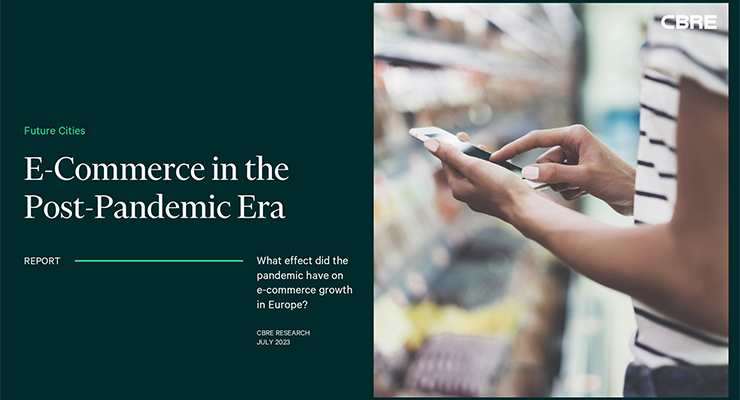In addition to Italy and Spain, the top six e-commerce markets in Europe include the United Kingdom, France, Germany and the Netherlands, which together account for 72 percent of total European e-commerce spending.
Logistics demand from online retailers back at the pre-Corona level
In 2019, online retailers accounted for 11 percent of the European logistics market’s space turnover. In 2020, this share rose to a record level of 33 percent, only to fall back to 15 percent by 2022. Significant differences can be seen in the individual markets: between 2019 and 2022, the total occupied logistics stock in Spain grew by 29 percent, the largest increase among the main European e-commerce markets. Growth in emerging e-commerce markets has been driven by rapid acceleration in technology adoption and infrastructure improvements. Nevertheless, only about one-third of consumers in Italy and Spain still have broadband Internet access. However, in addition to the expansion of distribution infrastructure, the growth of parcel lockers and pick-up points has made it more convenient for consumers to deliver their purchases online.
“Mature e-commerce markets are seeing a return to pre-pandemic e-commerce growth rates. The strong acceleration in the growth rate in emerging markets such as Spain and Italy suggests that online retailers and third-party logistics service providers will continue to account for a large part of the demand for logistics space in these markets”, says Tasos Vezyridis, Head of European Thought Leadership at CBRE.
Stationary retail is still preferred
Despite continued e-commerce growth, however, the data shows that consumers still prefer to store in stores: 65 percent of consumers in Italy and Spain prefer stationary retail. This is above the European average (60 percent) and well above the figures for the United Kingdom (52 percent) and Germany (55 percent). This is reflected in footfall and tenant sales in Europe’s high streets, which have largely recovered to pre-pandemic levels. The recovery in footfall was initially driven by retail parks due to their concentrated retail offer. However, according to CBRE’s data, regional shopping centers with leisure components recorded the highest frequencies at year-end 2022.
“Physical retail has a huge impact that goes far beyond simply being a place to shop”, adds Chris Gardener, Head of European Retail at CBRE. “Rather, visibility and the ability to experience and try out products act as a catalyst for e-commerce growth. For retailers, a strong omnichannel offering will be critical to achieving a balance between their online and offline channels as retail evolves.”
For more information, find the full report here.






